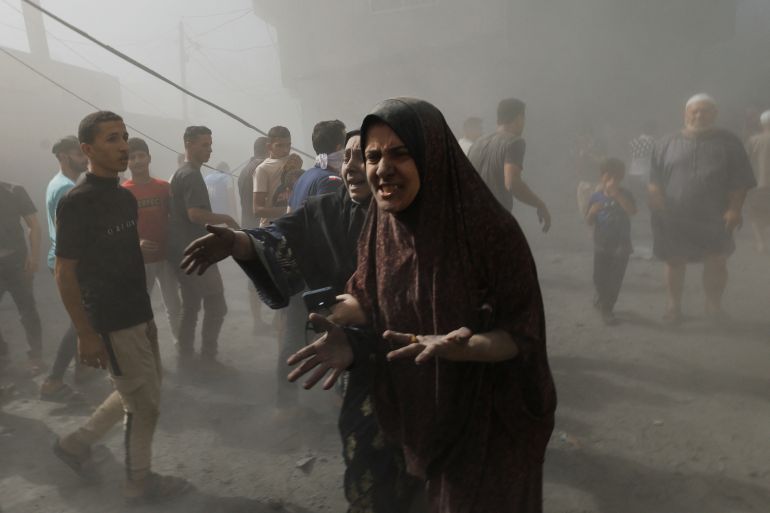Ceasefire, pause or truce? What have Israel and Hamas agreed to?
A look at the words dividing UN Security Council members in their efforts to temporarily halt fighting in Gaza.

Earlier this week, Israel and Hamas agreed to a deal under which they have committed to stop fighting for a four-day period and use the time to exchange some captives held by the Palestinian group and Palestinian prisoners languishing in Israeli jails.
Israel has been bombarding Gaza for more than six weeks, after Hamas fighters attacked southern Israel on October 7, killing about 1,200 people. More than 14,500 people have been killed in Israeli bombing, including about 6,000 children.
Keep reading
list of 4 itemsRed Cross’s Mamadou Sow: ‘I wish we could shield hospitals in Gaza’
Starvation used as a ‘weapon of war’ on civilians in Gaza: Oxfam
UN chief says ‘clear violations of international humanitarian law’ in Gaza
Under the deal, Hamas is to release 50 captives in exchange for 150 Palestinian women and children in Israeli prisons. The halt in fighting will continue for every day that Hamas releases another 10 captives after the initial 50, Israel has said.
But what does the deal, which follows mounting international pressure for a pause in the war, really bring? A ceasefire? A truce? A humanitarian pause? Or something else?
Ceasefire
It essentially means that the fighting stops. A ceasefire is subject to agreement by all parties and usually involves a formal political process with commitments to de-escalate conflict, such as withdrawing weapons or repositioning forces. It tends to cover the entire geographical area on which the war is being waged. It may lead to a permanent settlement.
Israel and Hamas have not agreed to a ceasefire.
This is the long-term option rejected by the United States, the United Kingdom and other countries which back Israel’s right to defend itself by continuing its war on Gaza. By contrast, United Nations Secretary-General Antonio Guterres has publicly called for an immediate humanitarian ceasefire.
Samir Puri, a visiting lecturer on war studies at King’s College London, thinks a ceasefire is “unimaginable” in the present circumstances, given that “a binding agreement with signatories and associated de-escalatory obligations” would be required. “They take real effort to negotiate in the first place,” he said.

Cessation of hostilities
Many use this term as a synonym for ceasefire. However, a cessation of hostilities is generally less structured. Agreements do not tend to cover issues like objectives, timelines, security and monitoring.
They enable parties to break from fighting as a step to talking and perhaps moving towards a sustained ceasefire. In this sense, cessation could be viewed as a potential stepping stone towards ending the war.
“It could be agreed to quicker and is not expected to last, necessarily,” said Puri.
But in many ways, what Israel and Hamas have agreed to is not even a cessation of hostilities.
Truce
It is the white flag option. The term truce is looser than a cessation of hostilities, with no formal negotiations. Parties in conflict may have decided to take a break after intensive combat. By their very nature, truces may come and go during a conflict, sometimes applying to specific areas.
This is how Qatar has described the deal that it has brokered between Israel and Hamas.
A truce can enable activities like the removal of the wounded or the burial of the dead. It is understood that opposing forces should not change positions while a truce is in force.
Humanitarian pause
This refers to the temporary cessation of fighting, purely for humanitarian reasons. Pauses are sometimes confined to a specific geographical area where the humanitarian activities are being carried out. Usually in force for a defined period, a pause can last as little as a few hours.
The US’s initial draft resolution omitted any mention of a pause, but underlined Israel’s right to defend itself and demanded that Iran stop arming its proxies in the region. It toned down the version rejected on Wednesday, including a “call for all measures necessary, such as humanitarian pauses”.
“A humanitarian pause would effectively be a truce to allow passage of aid or displaced people,” said Puri.
What Israel and Hamas have agreed to is more than a humanitarian pause — it also allows for the exchange of people.
Days of tranquillity
This is a mechanism that would grant medics and other personnel access to war zones on specific days. It is often used by UNICEF to ensure that children have access to healthcare during conflict.
It was first used in El Salvador in 1985 when the UN’s children’s agency negotiated a three-day break in fighting to enable children to be immunised.